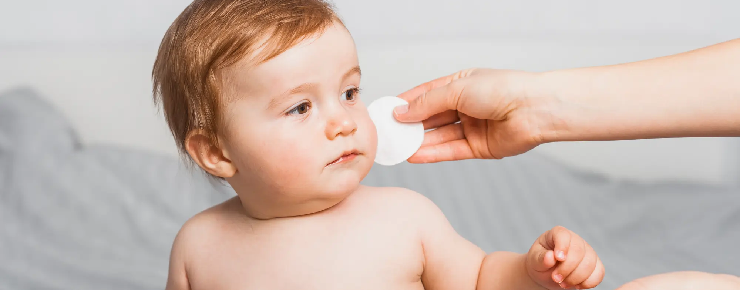Archives

Babies, with their soft and delicate skin, are prone to various skin irritations, and rashes are a common occurrence. These rashes can be distressing for both the baby and the parents. While some rashes may be harmless and go away on their own, others can be quite uncomfortable. In this comprehensive guide, we will explore why babies get rashes, what these rashes can lead to, and most importantly, how to treat them with safe and effective home remedies. We’ll also discuss the importance of having a caregiver at home and how to choose the right one for your precious bundle of joy.
Why Do Babies Get Rashes?
Sensitive Skin: A baby’s skin is exceptionally sensitive because it’s thinner and more fragile than adult skin. This sensitivity makes it more prone to irritation and rashes as it struggles to cope with various environmental factors.
Diaper Rash: Diaper rash is a common occurrence because prolonged exposure to moisture and friction from diapers can break down the skin’s protective barrier, making it vulnerable to irritation.
Heat Rash: Babies have difficulty regulating their body temperature, and this can lead to sweat becoming trapped in sweat ducts. As a result, heat rashes often develop, especially in warm and humid weather.
Irritant Contact Dermatitis: Baby products like soaps, lotions, and detergents can contain harsh chemicals that are too abrasive for a baby’s delicate skin. This exposure can lead to irritant contact dermatitis, resulting in rashes.
Allergies: Babies can develop allergies to various substances, and these allergies can manifest on their skin as rashes. It’s crucial to identify and eliminate potential allergens from their environment.
What Can It Lead To?
Infection: Rashes can create openings in the skin, making it easier for bacteria to enter. Untreated rashes can become infected, leading to more serious health issues.
Discomfort and Pain: Rashes can be incredibly uncomfortable for babies, causing itching and pain. This discomfort can make the baby fussy and irritable.
Crankiness and Sleep Disturbances: Discomfort from rashes can disrupt a baby’s sleep patterns, leading to sleep deprivation for both the baby and the parents. This can affect the baby’s overall mood and well-being.
Scarring: In severe cases, when rashes are left untreated or are recurrent, they can lead to scarring. These scars can persist into childhood or even adulthood.
Chronic Skin Conditions: Some rashes, if not managed properly, can evolve into chronic skin conditions that may require ongoing medical care and attention throughout a child’s life.
Treatment for Baby Rashes
Keep It Clean: Maintaining cleanliness is vital in preventing and treating baby rashes. Gently cleanse the affected area with lukewarm water and a mild, fragrance-free soap to avoid further irritation.
Avoid Irritants: Minimize exposure to potential irritants. Opt for fragrance-free and hypoallergenic baby products, and ensure that diapers and clothing are not too tight to avoid friction.
Diaper Rash Cream: Using a high-quality diaper rash cream containing zinc oxide helps create a protective barrier on the skin, promoting healing and preventing further irritation.
Hydrocortisone Cream: In more severe cases, a pediatrician may recommend a mild hydrocortisone cream to reduce inflammation and alleviate itching. Always follow the prescribed guidelines for its use.
Prescription Medication: If the rash persists or is due to an underlying medical condition, a healthcare professional may prescribe specialized treatments to address the issue effectively.
Home Remedies That Work
Oatmeal Bath: An oatmeal bath is a soothing remedy for irritated baby skin. Ground oatmeal can be added to the baby’s bathwater, creating a gentle and calming effect that can help alleviate discomfort and redness.
Coconut Oil: Natural and safe, coconut oil is an excellent moisturizer with added antibacterial properties. Applying a thin layer of coconut oil to the affected area can provide hydration while also protecting the skin from further irritation.
Breast Milk: For newborns, breast milk is a remarkable remedy. It contains antibodies and natural moisturizing properties that can help soothe and heal rashes. A few drops applied directly to the rash can make a difference.
Aloe Vera: Aloe vera is known for its healing properties and can be particularly effective for calming itching and inflammation. Keeping a bottle of aloe vera gel in the refrigerator adds a cooling sensation when applied to the rash.
Chamomile Tea: Chamomile tea, renowned for its anti-inflammatory qualities, can be brewed, cooled, and applied to the rash using a soft cloth. This gentle herbal remedy can help reduce redness and discomfort.
How Important Is It to Have a Caregiver at Home?
Safety: A caregiver plays a pivotal role in ensuring the baby’s safety. Babies are naturally curious and can get into potentially dangerous situations. A caregiver’s constant vigilance can prevent accidents.
Feeding and Diaper Changes: Caregivers assist with feeding and diaper changes, which can be frequent and demanding. This support allows parents to get much-needed rest and helps ensure the baby’s basic needs are met.
Emotional Support: Babies need emotional nurturing. A caregiver can provide love, cuddles, and comfort when parents are busy or unavailable, promoting a sense of security and well-being in the child.
Monitoring Health: A caregiver can keep a watchful eye on the baby’s health, identifying any signs of discomfort or illness early on. This vigilance is essential for early intervention and treatment.
Parental Well-being: Having a caregiver at home can give parents the opportunity to take a break, relax, and recharge. Reducing parental stress and exhaustion is crucial for maintaining a healthy family dynamic.
How to Choose the Right Caregiver
Experience: Seek caregivers with ample experience in caring for infants. They should be familiar with the unique needs of babies, including feeding, diapering, and soothing techniques.
Certifications: Verify that the caregiver holds relevant certifications such as CPR and first aid training. These certifications ensure they can respond effectively to emergencies.
Compatibility: It’s essential that the caregiver’s parenting style aligns with your family’s values and preferences. This ensures consistency in caregiving practices.
Background Check: Conduct a thorough background check to ensure the caregiver has no history of neglect or abuse. This step is crucial for your baby’s safety.
Trial Period: Consider a trial period where you observe the caregiver’s interactions with your baby before making a long-term commitment. This allows you to assess their compatibility with your family.
Understanding the reasons behind baby rashes, their potential consequences, and effective treatment options is vital for the well-being of your little one. Home remedies like oatmeal baths, coconut oil, and chamomile tea offer safe and natural ways to alleviate discomfort. Moreover, having a caregiver at home is essential to ensure your baby’s safety, emotional well-being, and your own peace of mind. When selecting a caregiver, prioritize experience, certifications, and compatibility to ensure your baby receives the best care possible. With proper care and attention, most baby rashes can be managed, allowing your precious bundle of joy to thrive in a loving and nurturing environment.
Facebook
Twitter
LinkedIn
Pinterest
You might also like
The Diagnostic Value of CT Scans
Lab test at Home Food Intolerance Doctor at Home Physio
August 17, 2024
The Vital Role of Vaccinations: Essential for All Ages
Lab test at Home Food Intolerance Doctor at Home Physio
August 17, 2024
Breastfeeding Awareness Week: Simple Tips for New Moms
Lab test at Home Food Intolerance Doctor at Home Physio
August 3, 2024
July 27, 2024
July 20, 2024

